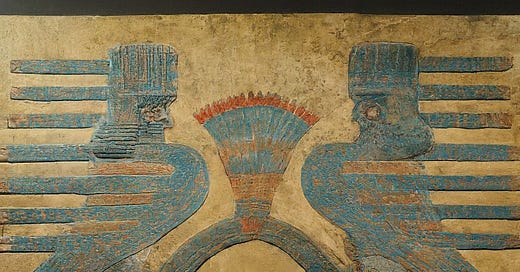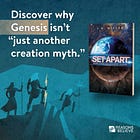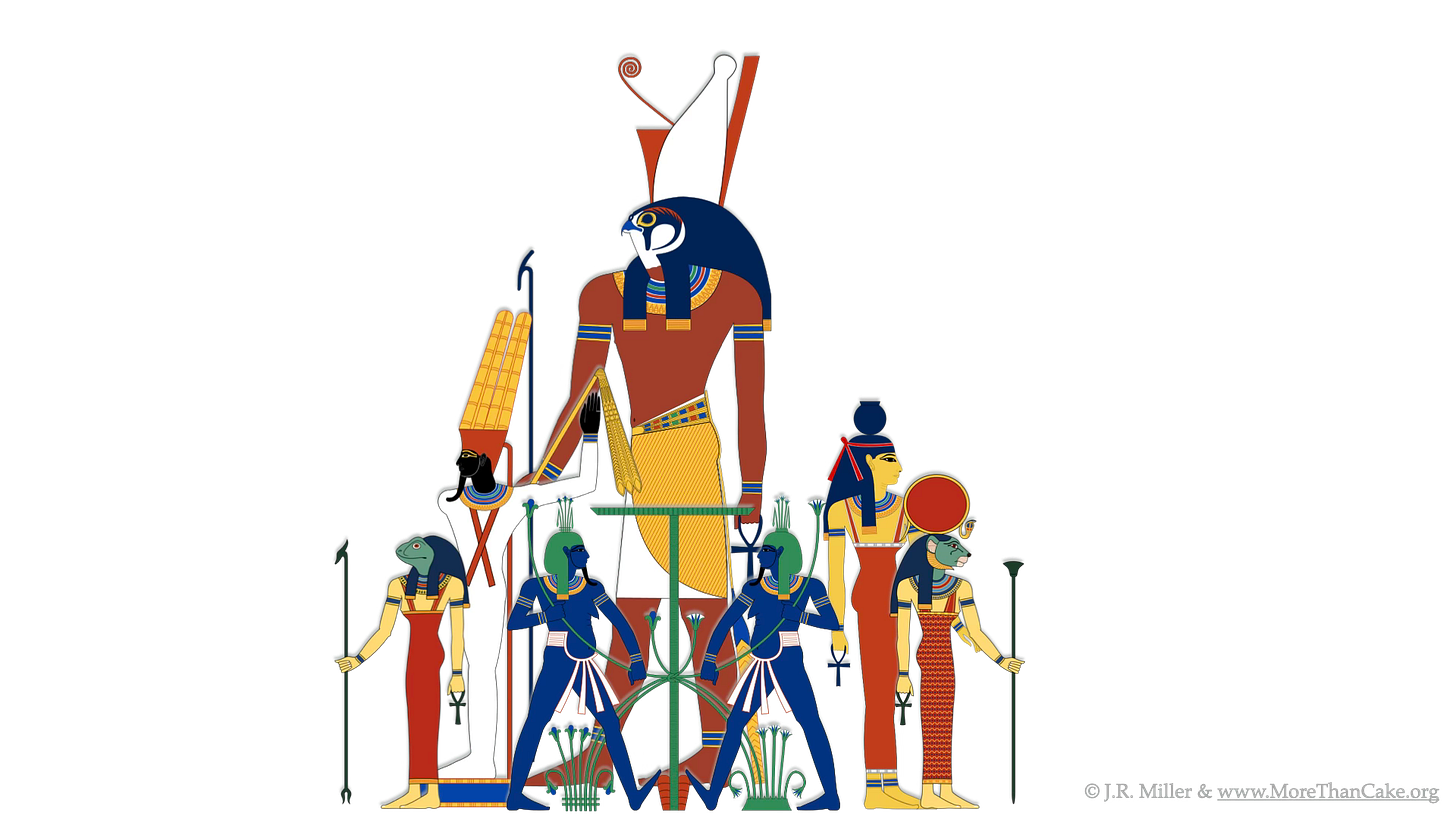My interest in the different creation stories dates back to the early 1990’s during my undergraduate studies in Engineering at Penn State University. During my junior year I decided to branch out and take a course in Old Testament. As a Christian, I thought this would be a fun experience, but very quickly my trust in the Bible was challenged and my eyes were opened to a whole new world divine legend. My class was taught by a well respected scholar named Gary N. Knoppers who did not believe Genesis was a true history of creation but just one of many creative imitations floating around the ancient world.
Fast forward a few years to my seminary days where I studied Old Testament under the brilliant scholar Roy Hayden. His expertise was in ancient Near East (ANE) civilizations. Dr. Hayden’s passion for the Bible, alongside his knowledge of the ancient world, rekindled my interest in discovering the connection between Genesis and these competing myths. My years of study turned into papers, my papers turned into dissertations, and now all that work gets boiled down to the release of my very short book Set Apart where I demonstrate how the creation story of Genesis is more than just a reimagination of these old world myths.
With that background in mind, I wanted to share with my readers this supplement to my book which compares the Babylonian and Egyptian myths of creation.
What is the ANE?
The ancient Near East (ANE) spans the 4th millennia BC through the Bronze and Iron ages into the 4th century BC when Persia fell to Alexander the Great. The ANE covered the land mass occupied by the modern countries of Kuwait, Iraq, Syria, Lebanon, Israel, Palestine, Iran, Turkey and Egypt. As one can imagine, over such a long period and across so many cultures there are a variety of mythologies crafted to tell the story of both cosmic and human origins.
For the reader unfamiliar with ANE mythology, below is a brief survey of the Akkadian version of the Babylonian myth of Enuma Elish and Egyptian Memphite creation myths. What follows is a short comparison between these two stories.
But before you read, you may enjoy this AI generated dialogue.
The Akkadian Myth of Creation
As Babylon rose to power in the middle of the Old Babylonian period, the city god Marduk also rose in prominence. As Babylon was raised to the status of the world’s leading city, Marduk was raised to the status of creator god. This Babylonian story of creation is called Enuma Elish and was recorded in several languages.1 The most well known version of Enuma Elish is written in Akkadian and dates back to ca. 1100 B.C. This epic was usually read on the fourth day of the new year’s festival of Akitû as a celebration of creation and reinforced Marduk and his city of Babylon as the primary force of the day. Marduk’s story ends with a recitation of his fifty cult titles and is a mixture of theogony (battle between the gods, cosmogony (origin of the material world), and hymn to the gods.2
This epic details the birth of the gods, the battle between Marduk and Tiamat, and the creation of man in a god(s)-ordered universe. The story is prototypical theogony detailing the genesis of the gods and the cosmos. The universe is the stage upon which the gods are the act and cause all things to come into being. The gods are depicted as the ultimate reality sustaining the world and the essential elements and forces behind nature.
In Enuma Elish, Apsu and Tiamat are representative of two great seas, Mummu is some form of water such as clouds, mist or ice, Ea is the earth, and Anu is the sky. Through great battles and intrigue the god’s establish their rule and power which corresponds to the earthly experience of the changing seasons and the mysteries of nature itself. The rising and the setting of the sun marks the daily battle between these two great gods. The crashing of the waves upon the shore is the battle between the sea and the land. Marduk sets himself above the other gods by killing Tiamat, splitting her body in two and creating the waters and the sky. This story is focused upon the gods as the rulers and sustainers of humanity. The gods create the seasons and change the course of daily life in the midst of their fury and destruction.
The Egyptian Myth of Creation
Traditionally each region of Egypt had its own god considered to be the creator or the god who instituted that city or region. Scholars have noted four main competing cosmological myths representing the rival sanctuaries of Heliopolis, Hermopolis, Thebes, and Memphis. A full summary of each tradition is beyond what I want to detail here in this post but Gordon H. Johnston provides an excellent summary of common elements to each of these myths [NOTE: subscribers can download a copy of his journal article at the end of the post).
Each of these myths followed the basic storyline:
the original undifferentiated monad evolved into primeval waters (Nun);
out of these waters (Nun) emerged Atum, the demiurge creator-god, who was generated/self-generated in the waters;
his generation in the waters was manifested by a sudden appearance of supernatural light;
at the dawn of time Atum the creator-god appeared on the primordial hill when the waters receded;
Atum generated the Ennead, manifest in the creation of the material world;
the apex of this theogony/cosmogony was the generation of Rê/Rê-Amun and corresponding creation of the sun as his divine image, whose birth was represented by the first sunrise;
the daily recurrence of the sunrise and sunset represents a continual process of a one-day creation mythology;
the creation of humanity was an accidental event—humanity sprang from the ground from the weeping (alternately tears of sorrow or joy) of the creator-god;
at the end of the one-day creative activity, the creator-god rested in satisfaction, not weariness; and
the creation cycle is completed by the mythical physical birth of pharaoh as the firstborn of Rê/Rê-Amun as the ruler of the terrestrial realm corresponding to the sun god’s role as ruler of the celestial realm.3
You can pick up Johnston’s work if you want a full analysis, but by way of introduction to the reader unfamiliar with Egyptian mythology, following is a summary of just one of these rival myths for the city of Memphis.4
During the First Dynasty (c. 3150–c. 2890 BC), the capitol of Egypt was established in Memphis, making it necessary to account for its centrality and importance above the other cities. Memphis was considered the place where the Upper and Lower lands of Egypt were joined as one, and as such Ptah, the god of Memphis, became the Primary creator god of all other gods.
Creation in this myth is treated in a very intellectual and matter of fact nature. Ptah, the city god of Memphis, is simply asserted to be the ultimate creator of all the gods, the creatures, the cities, and the men who lived in them. By his “thought” and “speech,” Ptah is asserted to be the creator of the creator god Atum, giving him authority above all other gods. The reader is then told that Ptah even created the gods Horus and Thoth—the gods who are commonly associated with the organs of the heart and the tongue. The heart in the Egyptian mind is the source of thought and the tongue is the figure of human speech and power.
The political purpose for establishing Ptah as the ultimate creator of the heart and tongue is that in doing so it bonds all creatures who have these two organs, men and animals alike, to Ptah is the source of their life.
With this foundation established, no person could question the centrality of Memphis or its power to rule Egypt. To deny Memphis would be to deny the rule of Ptah and his creation of all things.
The most striking element to this story is its transcendent approach to the gods and creation. The gods act upon one another with little mention of man or the universe. This is not to say that the Egyptians did not make these associations, but it is interesting to note that they are not made in this particular segment of the story. Creation establishes power and authority, the city who worships the most powerful god and can claim that god as their patron deity has the most authority and power. Ptah’s creative power is in his ability to speak his desires into reality—his heart desires and his tongue creates.
The Akkadian and Egyptian Myths Compared
Both the Egyptian and the Akkadian creation accounts derive from a similar background and purpose. They both attempt to establish a particular city as the capitol of a region by enthroning their god at the head of the pantheon of other city gods. There is a tremendous contrast in the styles presented in these two stories. The Egyptian myth is closest to the biblical account in emphasizing the creative word of god. There is no divine competition for the leadership; Ptah by sheer creative will establishes his authority over the pantheon. Marduk must contend for his position as head of the divine beings. His ability to create by a word is mentioned only as a minor ability; the real power lies in his ability to persuade and manipulate the other gods to his side of the battle.
Another outstanding difference between these two stories is the Akkadian emphasis upon the gods’ impact upon the seasons and consequently the daily lives of the people. The Egyptian god Ptah is more removed and reverenced for his creative power; whereas Marduk is reverenced not only for his initial creative work, but his continuing work and rule over the seasons. Most interesting is that while these two cultures share in their purpose for telling these stories, their method is extremely diverse. Both stories desire to establish political power for a particular city over a region or country by the manipulation of the pantheon. Ptah and Marduk in their respective cities become the key gods to create and rule over all other lesser cities and gods.
There is also something to be said in regard to these two stories and their relationship to the biblical account. The biblical story of creation is most different from the Babylonian myth. Enuma Elish focuses on the battle between gods, particularly Marduk's rise to power, and emphasizes the divine influence on the seasons and everyday life. The Genesis, however, is more similar to the Egyptian story in that the Memphite creation myth does not depict a war between the gods but presents an abstract concept of creation that emphasizes the power of Ptah to create from thought and speech. However, whereas the politics of creation played a central role in the Akkadian and Egyptian stories, this ancient realpolitik is remarkably absent from the Genesis account.
Although one might argue that the nation of Israel used this account to establish their authority among the nations, the lack of the theogony and the flat denial of any other god truly sets Genesis apart the from the fray of political intent.
The big takeaway is that Genesis differs from these myths in its focus on the creative word of God, devoid of divine conflict and political intrigue.
The Assyrian language version features Asshur and not Marduk. “Asshur was the chief deity in Assyria’s pantheon, present with Adad, Sin, Shamash, and Ishtar (Gwaltney, “Assyrians,” 101). Asshur came to be identified with the gods Marduk and Enlil, and thus assumed many of their features (Hauser, “Assur,” 186; Saggs, The Might that Was Assyria, 201–02). The Assyrian version of the Enuma Elish demonstrates this syncretism—in this text, Asshur replaces the original hero, Marduk (Bottéro, Religion in Ancient Mesopotamia, 227 n. 14; Jacobsen, The Treasures of Darkness, 167). The god was most commonly depicted as an archer in the process of loosing an arrow, wearing a horned crown, and enclosed by the winged sun (Hooke, Babylonian and Assyrian Religion, 33; Hauser, “Assur,” 186).” See, C. L. Shively, “Asshur, Assyrian Deity,” in The Lexham Bible Dictionary, ed. John D. Barry et al. (Bellingham, WA: Lexham Press, 2016).
James Bennett Pritchard, The Ancient Near East: An Anthology of Texts and Pictures, Vol. 1 (Princeton, N.J.: Princeton University Press, 1973), 31–39., James Bennett Pritchard, The Ancient Near East: A New Anthology of Texts and Pictures, Vol. 2 (Princeton, N.J.: Princeton University Press, 1975), 1–5., and Wyatt, Space and Time, 64–65.
Johnston, G. H. (2008). Genesis 1 and Ancient Egyptian Creation Myths. Bibliotheca Sacra, 165, 178–194, 182.
Pritchard, J. B. (1973). The Ancient Near East: An Anthology of Texts and Pictures (Vol. 1). Princeton University Press, 1–2.
Download PDF Resources
Keep reading with a 7-day free trial
Subscribe to More Than Cake to keep reading this post and get 7 days of free access to the full post archives.







